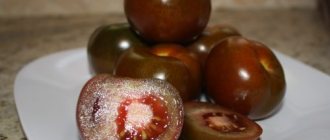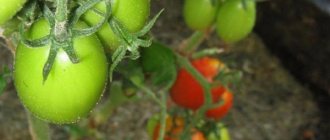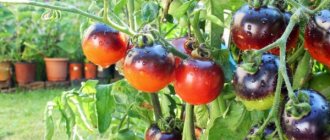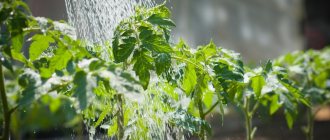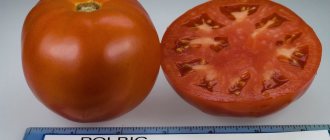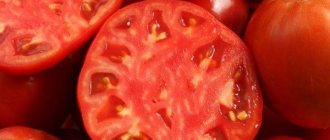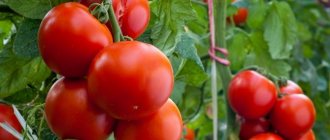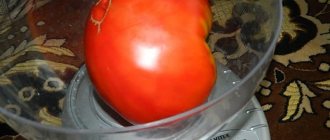Description and photo
A description of the bushes and fruits is presented below. The fruits have distinctive characteristics, and eggplant bushes are characterized by special varietal characteristics.
Fruit
Due to the size of the fruit, eggplant entered the block called Russian Bogatyr. Main characteristics:
- the length of the fruit, subject to the rules of agricultural technology, reaches 45 cm;
- the fruit is 9 cm or more in diameter;
- vegetable weight from 550 to 770 g;
- have a cylindrical shape;
- the skin is not thick, harsh, with a sheen, purple in color;
- The dense structure of the pulp is light beige in color, there are few seeds.
Eggplant Ilya Muromets is characterized by excellent taste. The bitter taste inherent in the vegetable is absent.
Bushes
The eggplant lives up to its name, as the bush grows about a meter in height. It has a branched structure, powerful and dense. The bush is spreading in width; eggplant can take up a lot of space on a plot; this aspect must be taken into account at the time of planting.
The branches of the bush are dense, with a slight edge. The color of the stems ranges from green to purple. The leading branches of the bush are thick, elastic, and do not bend under the weight of the fruit. The leaf blades of eggplant are large, in the form of an oblong oval, bright greenish in color with slight hairiness. The edges are partially corrugated.
Grafting eggplant onto tomato. Let's sum up the fruitful results of the first season!
The 2021 season has come to an end.
Reports on all testing have been submitted. And finally, it’s time to sum up the results of this year’s main experiment - growing eggplants grafted onto tomato roots. In a previous publication dated July 15, I wrote about the purpose of eggplant-tomato grafting - to try to get an eggplant harvest in Khanty-Mansiysk (in principle!) and in normal (July-August) periods . The chronology of the development of grafted eggplant bushes before the start of fruiting was also given there.
The eggplant season continued until September. True, the weigh-ins ended on August 30. After that there were very insignificant residual collections (the weather was not at all eggplant-like), the results of which would not have played a decisive role in my story. And without them, I think there will be something to tell about.
The total weight of the recorded eggplant harvest for the 2021 season was 29 kg 345 g. The figure is impressive for me. If previously all our eggplant harvests amounted to only a couple of kilograms (at best, under favorable weather conditions), then the result of this season, compared to previous ones, is simply - “Wow”!
A total of 12 bushes were planted: 10 in a film greenhouse, 2 in the AgroShchit greenhouse. 2 bushes on their own roots did not bear fruit at all. 1 'Roma' F1 bush grafted onto a tomato root had to be removed - there was no point in keeping it due to its very unfortunate location in the garden bed - it fell into impenetrable shadow (more on that later). Thus, the final yield was 9 eggplant bushes: 7 on tomato roots, 2 on their own roots.
For ease of perception, I have compiled the fruiting results for individual varieties and hybrids into “yield” tables, which I will accompany with data from the producers’ descriptions. And, of course, I will try to include photographs of all control weighings. I will lead the story according to the principle “from the best harvest to the worst (or lack thereof).”
Ads by
Eggplant 'Black Pearl' F1
The originator of the hybrid is ENZA ZADEN BEHEER BV. In 2015, the hybrid was included in the State Register of the Russian Federation. Designed for cultivation in open ground and under film covers in private farms. The manufacturer promises medium height, compact plants, with pear-shaped, medium-length fruits, weighing 300-320 grams. The declared yield of commercial fruits 'Black Pearl' F1 in open ground in the southern regions is 2.5 kg/sq.m. At the same time, the list of regions where it is possible to grow a hybrid is quite wide. It also has northern regions, including ours - West Siberian (however, only the more southern Tyumen region is indicated, but not the Khanty-Mansi Autonomous Okrug - Yugra, where eggplants are grown, rather, for fun).
In a film greenhouse, two 'Black Pearl' F1 bushes, grafted onto tomato rootstocks, grew, which, in my opinion, showed themselves very worthy. The table shows the overall result for two bushes that bore fruit almost equally.
I didn’t have time to photograph the first harvest of two large fruits (they ate it!), but it was at least 500 g.
Of all the varieties and hybrids, 'Black Pearl' F1 proved to be the earliest, strongest and most balanced in all respects, with high-quality, even, beautiful glossy fruits. He developed powerful bushes up to 1 m high. After tying the main trunk, there was no need to tie up the stepsons: he himself held them perfectly, even with fruits. It did not fall apart and did not interfere with the growth of neighboring bushes. Both the initial data of the hybrid and the good illumination of both bushes, which were located in different places in the greenhouse bed, worked in favor of sustainable fruiting.
One bush (in the diagram - No. 5) grew in the second row, surrounded by ungrafted bushes of 'Roma' F1, 'Almaz' and 'Black Beauty', which suffered greatly from the June cold, having lost almost all the seedling leaves (although in the seedlings they were very good). They were able to recover only by mid-July (and even then to varying degrees), but by that time 'Black Pearl' F1 had already grown thoroughly and began to bear fruit. The second bush 'Black Pearl' F1 (No. 10) grew in royal conditions - it received both southern and western sun.
Of course, in general, the space that I allocated to the eggplants in the greenhouse was clearly not enough. With the same care, those bushes that received more advantageous positions in terms of illumination bear fruit well. Eggplants are very dependent on the quantity and quality of sunlight. At the end of July, I had to say goodbye to one grafted bush of 'Roma' (in the diagram - No. 8, crossed out with a cross), on which very overgrown peppers decided to lean on the western side, and from the southeast - the unusually tall and spreading 'Ilya Muromets' piled up. (No. 7), which, however, also offended the more southern “Roma” (No. 9), but to a slightly lesser extent.
Eggplant 'Ilya Muromets'
Two bushes of this variety grew in the greenhouse (on their own root (No. 1 in the diagram) and on a tomato root (No. 7 in the diagram). Another bush of 'Ilya Muromets' grafted onto a tomato grew in the AgroShchit greenhouse. The originator of the variety is SELECTIONNAYA LLC COMPANY GAVRISH ". Authors: Gavrish S.F., Kapustina R.N., Verba V.M. The variety was included in the State Register of the Russian Federation in 2015.
Compared to other varieties, 'Ilya Muromets' was distinguished by its anthocyanin coloring of the stem. The manufacturer promises bushes 1 meter high, hung with long fruits of average diameter weighing 500 (up to 700) g. The declared yield of the variety under film covers is 6 kg/sq.m (according to information in the State Register) _______________________________________
I am somewhat lost in the calculation of yield per square meter adopted by experts. Based on the proposed planting scheme of 40 x 60 cm, 4 bushes of 'Ilya Muromets' should grow on one square meter, giving a total of 6 kg. My eggplants this year grew in two rows in a checkerboard pattern at a distance of 70-60 cm in each row. And they were very, very cramped (I won’t repeat that again!). It was especially crowded for 'Ilya Muromets' growing on a tomato root. Or it would be correct to say that it was cramped for all the bushes of other varieties and hybrids that were not lucky enough to grow around this very spreading bush. Both grafted bushes of the 'Ilya Muromets' variety readily grew stepchildren, on which a considerable part of the crop grew. I think that this variety definitely should not be cultivated; it grows easily both upward (in the greenhouse it grew to 1.6 m, the second bush has outgrown the height of 1.2 m of the AgroShchit greenhouse) and in breadth. I deliberately used figures of different sizes in the planting scheme (the smaller the diamond or circle, the lower the yield of the bush). Around the grafted bush of 'Ilya Muromets' all the figures were small; the neighboring bushes suffered greatly from his immodest behavior. In the greenhouse, it was “Ilya Muromets” that had to be tied up regularly so that he would not leave his neighbors completely without a harvest.
grafted onto the tomato behaved similarly in the AgroShchit greenhouse , where it had to be pulled to a support more than once, otherwise the harvest of hot peppers growing in the second row would have been in jeopardy.
Control measurements of the yield of one eggplant bush 'Ilya Muromets' growing on a tomato root in a greenhouse (in diagram No. 7). Total = 5 kg 499 g
Harvest of one eggplant bush 'Ilya Muromets' growing on a tomato root in the AgroShchit greenhouse. Total approximately 3 kg 407 g
also grew in the greenhouse on its own roots . Being very large even at the end of the seedling period, it was planted No. 1 (as indicated in the diagram). Great hopes were placed on him. But cold June took a toll on all ungrafted bushes, and 'Ilya Muromets' was no exception. However, thanks to its excellent varietal “abilities” and advantageous location (it caught the eastern and southern sun), it recovered much earlier than the rest of the ungrafted bushes.
An important role in the “resurrection” of all ungrafted eggplants was played by the planting of “hot grass” on July 17 throughout the entire eggplant-pepper bed. Unlike the grafted ones, for whom the “hot grass”, of course, was not superfluous, but did not become decisive - they were already pouring fruit, the ungrafted ones began to get better and mature before our eyes.
The ungrafted 'Ilya Muromets' was the first of this batch of eggplants to bear fruit. In general, the 2 kg 569 g given to him is two times less than what his brother gave on tomato root. But this is an absolute record for eggplant yield from one bush, grown in the traditional way under my conditions in Khanty-Mansiysk.
This season, probably due to the very warm winter, our slugs have become more active. They simply never existed, much less in such numbers. The first to suffer in the greenhouse were the marigolds, and the next to suffer were the eggplant fruits on their own roots. The slugs were not interested in the fruits of “tomato” eggplants at all! ___________________________________________________________________________________ It’s easy to calculate the average weight of one eggplant fruit of the ‘Ilya Muromets’ variety. It was approximately 200-230 g, regardless of whose root the bush developed on (its own or tomato). I don’t know, maybe it was worth keeping the fruits on the bushes longer. But when picking, I was guided by the sizes of young fruits that were familiar to me. There were also “dwarf” specimens, which for some reason did not want to grow in length, but became “soccer balls”.
The manufacturer recommends leaving 5-6 of the largest ovaries on the bushes by the end of July, and removing the remaining ovaries and flowers. Perhaps then it would be possible to achieve 500-700 gram fruits. But my goal was different - to consider the capabilities of a variety in specific circumstances, without regulating its development in any way (with the exception of grafting, of course). And then the record holder was the bush 'Ilya Muromets' growing in a greenhouse on a tomato root, which gave 30 fruits of different sizes, giving a total of 5 kg 499 g.
Eggplant 'Bibo' F1
Bibo, August 16 Originator - MONSANTO HOLLAND BV Included in the State Register of the Russian Federation in 2008. This early maturing hybrid is intended for cultivation in open ground in private household plots in the southern regions of the country.
(information from the State Register) This season I only had one bush of this amazing hybrid growing - on a tomato root, in the AgroShield greenhouse. I bought its seeds hand-packed, and therefore at the time of sowing and planting I forgot a little that 'Bibo' F1 produces white fruits. If I had remembered, I would have kept more (I gave a lot of surplus eggplant seedlings to friends). I especially regretted that I did not grow at least one more 'Bibo' F1 bush in the greenhouse. It would be very interesting to compare the quality of the harvest, because... even in conditionally open ground, 'Bibo' impressed me - with the evenness, beauty and taste of the fruits, their quantity, and the really friendly return of a considerable harvest in, albeit conditionally, the open ground of the Khanty-Mansi Autonomous Okrug - Ugra, where a full summer lasts at most two months. 'Bibo' F1, like its neighbor in the AgroShchit greenhouse 'Ilya Muromets', developing on a tomato root, already in July outgrew the height of the greenhouse (1.2 m) and also grew greatly in width, and the lower stepsons became full-fledged trunks, densely hung with fruits. And what is significant is that the slugs also avoided these bushes. For some reason, they were not interested in eggplant fruits on tomato roots, just as they were not interested in tomatoes growing in the same greenhouse. And in the open ground there were just a lot of them (I can judge by the unfortunate cabbage).
Eggplant 'Roma' F1
Three bushes of this hybrid were planted in the greenhouse.
Two are on tomato roots, one is on its own root. Originator - SAKATA VEGETABLES EUROPE SAS Included in the State Register of the Russian Federation in 2013.
This hybrid is intended “for cultivation in open ground and under film covers in private household plots. Mid-season hybrid. The plant is closed and tall. The stem has an anthocyanin color of medium intensity, pubescent. The leaf is large, green, wrinkled, the edge is slightly wavy. The fruit is pear-shaped, medium in diameter and medium in length, dark purple, highly glossy. There are no spines on the calyx. The pulp is whitish, without bitterness. Fruit weight is 220 g. The taste of the product after cooking is good. The yield of marketable fruits in open ground is 4.8 kg/sq.m" (information from the State Register)
Relationships with this hybrid were not easy to build. Two bushes grafted onto tomato roots were “hostage” to the peppers and the spreading bush of 'Ilya Muromets'. For this reason, as I wrote above, one bush of 'Roma' (No. 8) had to be removed. I left the second bush on the tomato root (No. 9), although it also grew in very cramped conditions, but unlike the remote bush, it could receive at least a little southern sun, because it grew near the southern wall of the greenhouse.
I attribute the modest yield result from the grafted 'Roma' to the growth conditions that were uncomfortable for the eggplant bush, as well as to the excessive, in my opinion, foliage - I did not have time to shorten and remove the large leaves shading the flowers, and just a few days later equally large following and etc. I’ll try it again next year, but in more favorable lighting conditions. The 'Roma' F1 bush, growing on its own roots, was one of the first to recover after the June “icing”, and the planting of “hot grass” inspired heroics: the bush quickly grew new foliage and by the end of the season managed to produce 7 fruits. In terms of light, this ungrafted bush was luckier than the grafted 'Roma'. Although he grew in the second “line,” in front of him stood two weaker, ungrafted bushes, which for a long time did not cause him any particular inconvenience.
Eggplant 'Black Beauty'
Two bushes of the 'Black Beauty' variety grew in the greenhouse.
One is based on tomato roots, the second is based on its own. Originator - LLC 'AGROFIRMA POISK' Authors of the variety: S.V. Maksimov, N.N. Klimenko
The variety was included in the State Register of the Russian Federation in 2006.
According to the State Register, the variety is recommended for cultivation in the Central Black Earth and North Caucasus regions “for cultivation in open ground in private household plots. (...) Mid-season. The plant is semi-spreading, of medium height. The stem is pubescent and has an anthocyanin color of medium intensity. The leaf is medium-sized, green, slightly toothed with spines. The fruit is pear-shaped, brown-violet, long, small in diameter, glossy. The spines on the calyx are rare. The pulp is yellowish-white, without bitterness. Fruit weight is 112-200 g. The taste of the product is excellent. The yield of commercial products is up to 336 c/ha, at the level of the Almaz standard. In the conditions of my greenhouse this season, only the 'Black Beauty' bush, grafted onto the tomato rootstock 'Intuition' F1, was able to bear fruit. The 'Black Beauty' eggplant bush, growing on its own roots, never reached fruiting. It suffered greatly in June, and bloomed magnificently only at the end of August - at the end of the eggplant season.
I was somewhat puzzled by the shape of the fruits of this variety: they really turned out to be pear-shaped (even pear-shaped) in the full sense of the word. Not long at all. I kept expecting that they would suddenly lengthen a little, but when the fruits began to lighten, I realized that it was time to remove them. Since the ungrafted bush never bore fruit, there was nothing to compare the shape of the fruit with. Perhaps this is how they were meant to be.
The yield of this bush in comparison with other grafted eggplants turned out to be average. But it was a variety, not a hybrid. And it grew in the second row (No. 6 in the diagram) - in the shadow of the hybrid 'Black Pearl' F1 (from the east), the already famous 'Ilya Muromets' (from the southwest) and overgrown peppers (from the west).
Eggplant 'Diamond'
This is what Almaz looked like in mid-July
Author of the variety: Andrievsky Anatoly Sergeevich Year of inclusion in the register of approved varieties: 1983. According to the State Register, 'Almaz' is a mid-season variety. “The period from full germination to the beginning of technical ripeness of the fruit is 109-149 days, depending on the growing region. The plant is compact, 45-56 cm high. (...) The fruit is cylindrical, 14.5-17.5 cm long, 3.0-6.0 cm wide. The color in technical ripeness is dark purple, in biological ripeness it is brownish-brown, glossy surface. The lower fruits touch the ground. The weight of the fruit at technical ripeness is 100-164 g. The pulp is greenish, dense, without bitterness. The taste and technological qualities are excellent. It is characterized by early and friendly branching, which contributes to the formation of a higher early yield. Marketable yield is 2.1-7.5 kg/sq.m (…). Recommended for growing in open ground. Suitable for mechanized harvesting."
This was the only bush of ungrafted eggplant that did not receive a grafted “brother”. He suffered the most in June. I thought I wouldn’t recover at all. He began to come to his senses later than all the other ungrafted eggplants - only after adding “hot” grass. By the end of the season, 'Almaz' arrived with a good leaf apparatus and new flower buds (he had lost all the first buds).
Such transformations and the will to live of this bush require that we give it its due! But the fact remains that 'Almaz', which grew on its own roots, never produced a single fruit.
These are the results of my eggplant experiment for the 2020 season.
For me, the conclusions are obvious - grafting eggplants onto tomato rootstocks brought noticeable results and a long-awaited harvest! Hardier tomato roots helped the eggplant bushes adapt without problems to the fairly cool soil of the greenhouse bed and not only emerge without loss after the long June cold, but also fully develop in order to begin bearing fruit at the optimal time and produce a noticeable harvest.
Of course, the behavior of different varieties was different, due to the specifics of each particular variety and hybrid. Probably not all varieties of this year will go with me into the future. I think that in general it makes sense to leave only the more modern Dutch hybrids. They are more flexible to grow and feel very comfortable in our climatic conditions. One problem is finding quality seeds. Those hybrids that you want to grow are not always available in small packages.
There is still much to be explored and tested in future seasons. In particular, I plan to try to use not only available varieties of large-fruited tomatoes as rootstocks, but also special hybrid tomato rootstocks.
Many thanks to all dear seven-dacha residents who followed the progress of this exciting experiment!
Special thanks to those who were able to read this publication to the end!
Characteristics of the variety
This vegetable comes from India; despite selective modifications, eggplant has retained its dependence on heat and light.
Productivity and fruiting
According to the ripening period, the variety is classified as mid-season. Four months pass from the time of sowing to the start of harvesting; the first vegetables become ripe by the second half of August.
The quantity and quality of the eggplant harvest is influenced by:
- sudden change in temperature (heat during the day, cold at night);
- dry atmosphere and elevated temperatures, the plant can shed its ovaries;
- Eggplant is negatively affected by a lack of moisture, but too much moisture leads to rotting of the root system;
- in a shaded area, the plant will not produce the desired harvest; when cultivating eggplant in a greenhouse, it is recommended to equip it with artificial lighting.
If the cultivation technique is followed, plants from 1 m2 in a greenhouse can be harvested up to 10 kg or more, in open beds 1.7-2 kg less.
Application area
This eggplant is recognized as a versatile species. It is cultivated for commercial purposes, for the production of sautes and caviar, and is used in restaurants, where it is a component of vegetable and meat dishes. Suitable for grilling, stewing and marinating.
Resistance to diseases and pests
The plant is noted to have immunity to fungal and viral diseases, as well as to parasites. The main harmful insects are the larvae of the Colorado potato beetle. The risk of damage by harmful insects to plants growing in open ridges increases. In a greenhouse with excessive humidity and low temperature, aphid damage is possible.
This variety of eggplant is not affected by late blight and powdery mildew. Diseases such as black rot and black leg are a consequence of improper plant care. To eliminate the problem, you need to reduce watering, wait for the root ball to dry out, and remove damaged plants.
Peculiarities
High eggplant yields are ensured by the complete absence of barren flowers. All ovaries give results. Vegetables are perfectly stored after harvesting and tolerate transportation well.
See also
Description and characteristics of the Nutcracker eggplant variety, cultivation and care
Read
Advantages and disadvantages
The eggplant variety in question has no significant disadvantages. Gardeners note the following positive aspects of the species:
- abundant flowering of the plant, good yield due to fruit setting on each flower;
- has immunity to diseases, is not afraid of most harmful insects;
- the plant does not need special care;
- the fruits are characterized by high taste and do not have bitterness;
- the ability to grow in a greenhouse and in open beds makes the plant accessible to most areas;
- vegetables can be stored for a long period and tolerate transportation well.
The disadvantage is the plant's requirement for sufficient lighting and stable temperature values.
Description of the eggplant variety
The Ilya Muromets variety was developed by Russian scientists. In 2021 it was added to the State Register. Eggplants got their name due to their heroic size and endurance - the variety was specially tested for the possibility of growing throughout our country.
Distinctive features
Eggplant varieties Ilya Muromets have characteristic features:
- large fruits up to 50 cm long, 10 cm in diameter and weighing up to 750 g;
- yield up to 10 kg per 1 m²;
- each flower produces an ovary, there are no barren flowers;
- excellent taste without characteristic bitterness;
- versatility of purpose;
- long-term storage;
- transportability;
- ease of care;
- resistance to diseases and pests;
- Possibility of growing indoors and outdoors.
Characteristics and yield
Ilya Muromets is a mid-season variety. On average, 110–120 days pass from germination to fruit harvest. The culture comes from India, therefore it is demanding of light and warmth.
The height of the bush does not exceed 80 cm, but it is spreading, so it requires shaping and staking. The branches are dark green or purple. The stems are thick and strong. The leaves are large, oval, bright green. The flowers are white at the base and purple at the edges.
Reference. The high yield of the Ilya Muromets variety is ensured by the absence of barren flowers; each flower produces an ovary.
With proper agricultural technology, eggplant fruits can reach a length of 45 cm, a diameter of 10 cm and a weight of 550–750 g. The yield reaches 10 kg per 1 m² in a greenhouse, in open ground it is 1.5–2 kg less. The skin of the fruit is thin, hard, shiny, purple with a black tint. The pulp is light beige, dense, without bitterness. There is no seed nest.
Growing seedlings
To shorten the growing season, it is recommended to plant seedlings. You can prepare the seeds yourself; eggplant is not a hybrid; therefore, the seed material retains all varietal characteristics and has a shelf life of up to 5 years.
Timing
At the end of February, it is necessary to prepare a place in the greenhouse or container for sowing eggplant seeds.
Soil preparation
If the seedlings are grown in a greenhouse, the soil is loosened, organic matter and ash are added. The soil must be moist. When grown indoors, sowing is done in containers filled with peat or soil mixed with compost.
Seed sowing scheme
Treat the seed material with a manganese solution for disinfection. Make furrows in the soil, going 2 cm deep, and place the seeds.
When sowing in containers, furrows are made at a distance of 5 cm with a recess of 1.5-2 cm. Plant the seeds at a distance of 4-5 cm. Irrigate with warm water.
Growing eggplants
The variety Ilya Muromets Russian Bogatyr, like all similar crops, has a long germination period. Therefore, in order to get an early harvest, eggplants must be grown in seedlings.
Time for sowing seeds
The sowing time of Russian Bogatyr depends on the chosen growing method. Thus, according to the observations of experienced summer residents, if eggplants are planted in greenhouse structures, it is better to plant the seeds in mid-late February. In this case, the seedlings for transplanting to a permanent place of growth will be ready by the 15th-20th of May.
If eggplants grow in open ground, the seeds are planted at a later date. The optimal time for this is considered to be the second half of March.
See also
How to properly grow eggplants and care for them in open ground, agricultural technologyRead
Sowing seedlings
Before you start sowing eggplants, you first need to prepare the soil material. To do this, you need to mix 2 parts of humus and one part each of the top layer of soil and sand. Then it is recommended to add 60 g of superphosphate and 2 tbsp to 1 bucket of the resulting mixture. l. wood ash.
After the procedure, the soil material is mixed well and placed in peat pots.
The process of sowing seeds is carried out in the following way:
- The planting material is treated with potassium permanganate and placed in hot water at a temperature of +50 degrees for 15 minutes.
- After the specified time, the seeds are planted in moist soil to a depth of 2 cm.
- The seeds are covered with soil and watered using the air-drop method.
- Peat pots are covered with film and placed in a dark place with a temperature of +25 degrees.
When the first shoots appear, the container is freed from the covering material and transferred to the windowsill. Over the next week, it is recommended to maintain a temperature of +16 degrees during the day and +13 degrees at night. Then the air temperature is raised to +28 degrees.
When growing seedlings, you need to take into account the fact that they do not tolerate drafts well. Therefore, when ventilating the room, it is recommended to cover young seedlings or move them to another place.
Choosing a landing site
In the case when eggplants of the Ilya Muromets variety are grown in open ground, it is very important to choose the right place for their growth. Taking into account the characteristics of the culture, the beds must be located in a well-lit area, but at the same time protected from direct sunlight and wind. As a rule, such places are located along the walls of fences or greenhouses.
The best predecessors for eggplants are:
- cabbage;
- legumes;
- cucumbers;
- carrot;
- zucchini;
- pumpkin.
At the same time, it is not recommended to plant eggplants in places where potatoes, peppers, tomatoes and other nightshade crops were previously grown.
Transplanting
Seedlings are planted in greenhouse structures in mid-May. Transplantation into open ground occurs at the beginning of June, when consistently warm weather sets in.
The standard for planting eggplants in open and closed ground is the same; it is carried out as follows:
- In the selected location, holes are dug according to a 50 x 70 cm pattern.
- A support is installed in the holes.
- Each depression is watered generously with warm, settled water.
- Pre-moistened seedlings are carefully installed in the prepared holes in a vertical position, without disturbing the root system.
- The plants are covered with soil and tied to a support with braid.
After the manipulations, the soil around each seedling is mulched with dry straw and peat.
Care
14 days after sowing, shoots appear. With proper care, by mid-May, eggplant seedlings will be ready for planting in the prepared area.
Temperature
Particular attention is paid to the temperature in the greenhouse; it is not allowed to go below +15o C.
Daylight hours
Eggplant is a light-loving plant. The container must be placed in a warm place, the place must be sufficiently illuminated, and covered with film. When sprouts appear, remove the cover and protect the seedlings from direct sunlight.
Irrigation
Before germination, the soil is watered regularly once a week. After the sprouts appear, irrigation occurs as needed, but not more than once every 10 days.
Top dressing
Seedlings need nutrition. If the growth is weak, the sprouts need to be fed with organic matter; it is recommended to use an infusion of bird droppings diluted 1 to 15.
Picking
After 21 days, the seedlings are ready for picking. To avoid damaging the root part, carefully remove the sprout from the container and place it in a prepared container. Peat pots are ideal; in the absence of such, they can be planted in plastic glasses. After a week, the seedlings are ready for planting in open beds or in a greenhouse.
Additional feeding
Additionally, foliar feeding is carried out 6 days before planting in a permanent place. Necessary to increase resistance to external aggressive factors and improve survival rate. For this purpose, humates and mineral fertilizers are used. Agricola is excellent.
Additional root feeding is carried out if the seedlings are weak. Complex products are used - nitrophoska, Kristalon, Kemira.
See also
What are the benefits of eggplants for the health of women and men, harm to the body and contraindications
Read
Features of planting and care
To reduce the growing season, it is recommended to plant seedlings. The material can be collected independently; “Ilya Muromets” is not a hybrid crop, so the seeds retain all the characteristic features of the variety, are stored for about 5 years, giving good seedlings.
Attention! To obtain a good harvest, it is recommended to update planting material approximately once every 3 years.
Seedlings can be grown in a greenhouse. In the second half of February, a place for eggplants is prepared. It is necessary to loosen the soil, add organic fertilizers and wood ash. Make 2 cm depressions in the soil, plant seeds, and moisten the soil. After two weeks, young shoots appear; it is necessary to monitor the temperature in the greenhouse; it should not fall below +15o C. If necessary, the soil is watered no more than once every 10 days. By mid-May, the “Ilya Muromets” eggplants will be ready for planting in the designated area.
You can grow seedlings indoors. Seeds are planted in containers with peat or soil half mixed with compost at the end of March. Algorithm of actions:
- The planting material is treated with manganese (light pink solution), then placed in a growth-stimulating preparation for 2 hours (can be purchased in a store).
- Furrows 1.5 cm deep are made at a distance of five centimeters from each other, seeds are planted in them, and watered with warm water (+25o C).
- The container is placed in a warm, well-lit place and covered with film on top.
After germination, the film is removed and the container is blocked from direct sunlight. After 21 days, the seedlings are ready for picking. Carefully, so as not to damage the root, each eggplant sprout is removed from the container and placed in a separate container. Peat pots are optimally suited for these purposes; if they are not available, you can plant them in plastic cups.
In this state, the “Ilya Muromets” eggplants grow for a week; they are watered as the top layer dries. The planting material is ready for planting in the greenhouse. Eggplants are planted in open ground, provided that the ground has warmed up well. If spring is late, the seedlings feel comfortable in glasses and will happily wait their time.
Before planting in open ground, a site is determined. It should not be in the shade or lowland with high humidity. In a place exposed to the sun, eggplants will also be uncomfortable. The south side behind the wall of the building is best suited. The soils selected are fertile with a neutral acid-base composition.
At the planting site, as in greenhouses, the soil is loosened, weeds are removed, and organic matter is added (2.5 kg/1m2). Seedlings in peat containers are planted along with them, plastic cups are cut, and the eggplants are removed along with the root ball.
The distance between rows is 60 cm, between bushes - 50 cm. Planting work in the greenhouse is carried out in mid-April; seedlings are planted in open ground as the soil warms up, approximately in early May.
Attention! The “Ilya Muromets” eggplant does not tolerate nightshades (tomatoes, potatoes, peppers) near it, but it feels comfortable near the cabbage bed and next to cucumbers.
After planting, care for the variety is standard, watering until flowering once a week, then as needed. Weeds are removed, and when a crust forms, the soil is loosened. The first fertilizing is applied at the root 21 days after planting, organic fertilizers are used. The second is done after 2 weeks with preparations containing phosphorus. After flowering, a bush is formed, all leaves are removed up to the first stem fork. Small flowers are removed from the lower branches.
Care
Proper and proper care affects the quality and quantity of the harvest.
Watering and soil care
After planting, the plants are watered once a week, then as needed. An important component is soil care: loosening, removing weeds.
Top dressing
Apply the first food at the root on the 21st day after planting; it is recommended to use organic matter. The next feeding is carried out after 14 days with preparations containing phosphorus. It is better to feed in damp weather when it is rainy. In dry weather, the soil should first be moistened.
Spraying against pests and diseases
During the growing season, the plant suffers from some diseases. The main ones are root and basal rot, tracheomycosis (fusarium, late blight, verticillium), leaf mosaic. The fight against diseases is carried out by a number of measures in which the soil and the ground part of the bush are treated. Are used:
- biochemical preparations do not harm beneficial insects (bees), animals and humans;
- chemicals that can quickly destroy the disease, but have a negative effect on the human body, since the chemicals accumulate in the fruits;
- traditional methods using infusions of plants that have fungicidal and insecticidal properties.
Dangerous pests for eggplants are the Colorado potato leaf beetle and aphids, which can destroy the plant in a few days. For destruction, “Confidor Extra”, “Aktara”, “Decis-Profi”, “Inta-Vir” are used. All treatment procedures are stopped before the onset of mass flowering of the plant.
Some gardeners use traditional methods of combating harmful insects: a decoction of wormwood, yarrow, pollination and irrigation with ash. Beetle larvae are eliminated with a mixture of onions, garlic cloves, dandelion and soap.
Bush formation
At the beginning of the flowering period, carry out the formation of a bush:
- cut off the leaf blades located up to the first fork on the plant trunk;
- Remove small flower stalks from the lower branches.
How to grow?
Seeds begin to be sown at the end of February, on February 25th. A week before the specified date, it is recommended to germinate them in advance. The seeds are washed and kept in water. Seeds that have sunk to the bottom are suitable for sowing; their core is well formed.
Next, disinfection and hardening are carried out. For disinfection, use a solution of potassium permanganate. Dilute potassium permanganate to a rich burgundy shade. Keep the material for sowing in it for 30 minutes. After this, the seeds need to be “awakened”. To wake up, use special solutions:
- melt water; the seeds are kept in it for 12 hours;
- 1% hydrochloric acid solution – 30 minutes;
- “Epin” 10 drops/l of water – 1 tsp.
After processing, the seeds are kept in a damp cloth, moistening it regularly. They ripen at 14 C. They are put in the refrigerator at night. The optimal temperature is 10 C. After 7-10 days they germinate. They are planted in the ground:
| № | Helpful information |
| 1 | for soil they can withstand a temperature of 25 C. It is made up of 2 parts of garden soil, 1 part of peat and 1 part of sand. It should be warm, loose and moist |
| 2 | Peat cups are used for planting. They are filled with prepared soil, a 2 cm deepening is made, and a seed is placed in each cup. |
| 3 | Further seed ripening occurs at a temperature of 30 C |
| 4 | The cups are covered with film and the soil is ventilated daily. |
| 5 | sprouts appear after 14-21 days. They are immediately strong, with a well-developed root system |
Before planting seeds, it is recommended to spray the soil with an ash solution for disinfection. The solution is prepared from 1 kg of ash and 10 liters of water. Insist for 1 day. The solution is filtered, heated to 25 C, and treated using a spray bottle.
When 2 leaves appear, remove the film from the cups. Further cultivation of seedlings occurs at a temperature of 25 C. With the appearance of 4 leaves, the temperature regime is adjusted. The daytime temperature is gradually reduced to 20 C, the night temperature to 15 C.
More on the topic: Care and cultivation of eggplants in a greenhouse
Water the seedlings 2 times a week using a spray bottle. You can use Epin as a growth stimulant, but for the Ilya Muromets variety this is not necessary. The seedlings are actively developing.
View this post on Instagram
Publication from Vasilich (@kladovaiavasilicha) Sep 12, 2021 at 12:00 PDT
If sowing was done at the end of February, then the seedlings are planted in the ground or in a greenhouse at the beginning of May, 05.05. Always pay attention to weather conditions. The soil should warm up to 15 C.
If frosts occur at night in May, it is recommended to plant the seedlings in a greenhouse, or keep them in greenhouse conditions until the air temperature becomes more stable.
The optimal growing regime is 18-20 C during the day, 10 C at night. Water the eggplants once every 10 days. The soil should not be too wet. Young berries should be expected 4 months after sowing.
Eggplant Ilya Muromets is picky about light conditions. The plant develops well with a daylight period of 14 hours. If in the northern region the day is short, then it is recommended to install fluorescent lamps in the greenhouse.
For eggplants, you need to choose the right site. A site where legumes or melons were previously grown is suitable for the crop. Crop rotation will prevent the development of viral and infectious diseases.
Harvest and storage
The first fruit harvesting on average begins 35-40 days after the plant blooms. The ripening of the fruit is indicated by the rich purple skin with a dark tint and the density of the pulp. The fruits are collected using scissors, leaving a stem 4-5 cm long.
Eggplant fruits can be stored for quite a long period of time. If the required temperature (+10 °C) and air humidity (90%) are maintained, the fruits do not lose their commercial quality for about a month, provided that the eggplants are kept in a dry, dark room.
Landing
Seeds are disinfected in potassium permanganate (a 1% solution is prepared). You can use Fitosporin, Fundazol. Suitable stimulants include Epin, Bioglobin, and Agate. Exposure time up to 3-5 hours.
The soil mixture is made up of turf and compost substrate with the addition of peat, vermiculite, and vermicompost. The soil is spilled with warm water, grooves are formed in increments of 5 cm. The seeds are laid out at a distance of 3 cm. The optimal seeding depth is up to 2 cm.
Picking is necessary 2.5-3 weeks after germination (phase of appearance of 2 leaves). After 5-7 days, the bushes are fed with Kemira and Fertika. Before planting in stationary beds, plants are hardened off for 10-12 days. The temperature is gradually reduced to 14-15 degrees.
Secrets of vegetable growers
When cultivating eggplants, experienced gardeners share secrets that contribute to the good development of the plant, which affects the quality and quantity of the harvest:
- When growing seedlings, use peat pots. Planting eggplants in open beds occurs without stress, the plants are strong and healthy.
- Choose the south side of the house or fence for planting so that they serve as protection for the plant from the winds.
- Eggplant bushes need to be watered and irrigated with warm water.
Description of the heroic variety
Mid-season eggplant variety Ilya Muromets for growing in open ground and under film reaches technical ripeness in 110–115 days after full germination.
In the southern regions, eggplants of the Ilya Muromets variety are cultivated in open ground, in the central and northern regions - under film cover and in greenhouses. Film tunnels are preferable: heat-loving eggplants overheat in the greenhouse on hot days and can lose their ovary and color.
The variety lives up to the name Ilya Muromets: the bush reaches a height of 1 m, is branched, dense, powerful. The fruits of a deep dark purple color are striking in size - irregular spindle-shaped cylinders with a diameter of 10 cm and up to 40 cm in length, weighing more than half a kilogram. The yield of the variety exceeds 10 kg/m2. Favorable reviews contribute to the spread of the Ilya Muromets eggplant variety.
Diseases and pests
As a rule, the development of diseases in eggplant Ilya Muromets is affected by improper care.
If you limit plants with light, timely watering and fertilizers, they begin to suffer from diseases such as:
- leaf curling;
- blackleg;
- yellowness of leaves;
- black spot;
- powdery mildew.
It is possible to cope with these diseases only in the first stages of their development. Therefore, it is worthwhile to inspect the plants in a timely manner and take appropriate measures.
One of the most dangerous pests that can cause damage to eggplants is the Colorado potato beetle. A more effective method to combat them is to collect insects and their larvae by hand. If gardeners have little free time, it is recommended to use insecticides.
